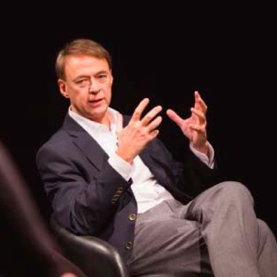Q&A with author Mervyn Dinnen: How to gain a competitive edge by attracting, hiring and engaging the right talent
- 9 Min Read
Co-author of the book ‘Exceptional Talent,’ Mervyn Dinnen joins HRD Connect to reflect on the competition between disrupters and non-disrupters, talent economy and attraction. The author also highlights the idea that millennials are not a special case and we are “social creatures at any age.” The digital revolution has created new roles requiring skills which […]
- Author: Unzela Khan
- Date published: May 24, 2017
- Categories

Co-author of the book ‘Exceptional Talent,’ Mervyn Dinnen joins HRD Connect to reflect on the competition between disrupters and non-disrupters, talent economy and attraction. The author also highlights the idea that millennials are not a special case and we are “social creatures at any age.”
The digital revolution has created new roles requiring skills which HR have never had to hire for, practically, how do you amend your HR process to qualify candidates appropriately for these roles?
Historically, we have gone about hiring people by creating a role around how somebody has done it before. So we have looked at how a previous person has done the job and we seek to hire somebody that replicates that person or that job – and that leads to bad recruitment practice because perfect matches don’t exist.
We have to really understand what we want somebody to do. The HR recruitment team need to push back on the hiring manager and understand for themselves exactly what the vacancy is. What do we need someone to do? What skills do they need? Why do they need those skills?
The digital revolution creates new roles which require new skills, so if we’re looking to assess for skills we haven’t before, then we need to understand what level of skill. We need to set them tasks, we can’t select from a CV, we can’t say “if a person has done A they will be able to do B.” So we need to make that open; rather than look for people with specific experience and specific industry.
We need to look for people from a whole diversity of backgrounds, the attraction process has to move away from screening people out. We need to be open. The only way we can do that is to understand. That is why HR has to get closer to different parts of the business and understand what is the role, what we want somebody to do.
The need for the culture of socialisation is increasing as millennials enter the workforce – how can organisations facilitate this culture?
This now needs to be done through the on-boarding phase. Historically we used to make someone an offer, tell them what the start date was and that was it until day one when they would turn up. Half the people weren’t expecting them and most of their team members didn’t know someone new was joining that day. Now, we start off on-boarding people from the interview process. The key phase is to actually start connecting people socially with their team members.
So at the start of day one, they have already connected through the traditional social platforms of LinkedIn or Twitter, social media accounts of the business and any internal communication platforms like ‘Yammer’. They begin to build relationships with their team members, they find out what people talk about, what their interests are and what they share. The other important thing is to connect them with other new staff – then you’ve got a peer group building of people all starting at the same time. They’ve got a shared experience and shared learning so they can help each other.
However, it is not a millennial thing – we are social creatures at any age. Just because we didn’t have the technology to do it 20 years ago doesn’t mean those people don’t want to do it now. If you look at the main reasons people leave a new job within six months, the first one is that the job isn’t what they expected it to be, the second one is that the culture of the business isn’t to their liking, and the third one is they don’t feel they have a good relationship with their manager or their colleagues. Two and three are dealt with by connecting people early. So this kind of social interaction and feeling part of the team before you start is crucial.
“The modern HR team has to cater for all expectations and preferences, in a way that is both diverse and inclusive, and enables all employees to deliver their best work.” What can HR do to offer a more personalised strategy to ensure that individual employees remain engaged and productive?
Pretty much everybody that we see will be using technology in their personal lives. Everybody that we hire will have a phone. Some ages might be better at it but that’s not because other people don’t want it, they haven’t known any time before it, it’s been there all their lives.
Part of the difficulty you get in organisations, and I’ve seen this happen many times is that digitalization is put on people. “We’re going to digitalize” – all managers now have an iPad. If you’ve managed a team for 15 years without an iPad, the iPad itself isn’t the problem because you’ve probably got one at home – it’s the way your job has changed that might be a problem.
HR is rarely part of the digitalization process, it’s rarely part of the conversation around digitalization and technological advances. They are just told what is going to happen. They might get a knock on the door saying: “We need a new learning system” but they’re not very good at supporting the established workforce through that change.
51% of millennials buy stuff online, 49% of Gen X and Baby Boomers buy stuff online, so that isn’t much of a difference. It’s not like one group does it, and another group doesn’t. One group has just taken longer to adopt it, that’s because it’s a big behavioural change, whereas there was no change for millennials because that’s all they’ve ever known. It’s understanding that for your established workforce, when you change the technology and when you bring in new processes – it is a change.
It’s not necessarily offering a more personalised service, it’s understanding that not everybody does things at the same speed and in the same way, and that when you change your process, for some people, that’s all they will know, but for a large part of your workforce – that is a change.
How can non-disrupters and mature companies compete against disrupters in the current talent economy?
A lot of this comes down to the employer brand. Employer brand as a concept seems to be something that has only been around for last few years. But really, it didn’t start with the internet. There have always been iconic employers. If you go back to the eighties, people wanted to work for Marks & Spencer’s, big advertising agencies, this wasn’t based on some kind of employer brand, they were good solid names and everybody liked the company. The belief was that you will get paid well, looked after and you can have a nice career with them. That was based on a perception of consumer brand. There have always been iconic employers of choice – which when you got inside weren’t really great places to work with.
We have that now, most millennials would see companies like Google and Facebook as the places they would want to work. They are the top brands in their lifetime. Companies who are established in other industries and need technical staff find themselves competing against companies like Google, Facebook, LinkedIn and Twitter for the same kind of people. Ultimately it’s about being somewhere where people want to work.
So how do companies who have a bad reputation or work in a sector with a bad reputation attract staff? Or how do you recruit when you don’t want people to know what you do?
The way these companies get staff is by being great places to work and recognising that the people who work there are likely to be customers, or likely to know people who are customers. Fast-food places are the perfect example, they know that everyone who applies there is likely to be a customer, why else would you work in a fast food place? If you apply for a job there and you’re treated badly you could take your money to another fast food place. So they know that if you apply for a job there, they have to treat you like a customer as opposed to an applicant. They have to make sure that even if they don’t hire you, you still carry on going to them to buy meals.
That’s what companies have to do. But now it’s not just the brand, you build relationships and connections with people. So companies have to be great places to work.
What key elements create an irresistible workplace that continues to attract and engage a high performing workplace
The way that we attract talent has changed. Historically, when we have a vacancy we create a job description, we place an advert, we get some people in to interview, we make them an offer, and four weeks later they’ll turn up, then we’ll introduce them to the business, give them a probation review after three months, and then at the end of the year we’ll give a performance review, after two years we’ll promote them and that was it.
What I call “the new talent journey” is not a series of events; it’s an ongoing process. People know about the organisation before there is even a vacancy to apply for.
The way we connect to an organisation and a vacancy is different, it might be through digital, it might be through social. We are probably applying to a company we know something about, and know what it’s like to work there.
The assessment process really begins in that phase. Rather than going through the gladiatorial interviews and the trick questions to catch you out, the modern recruitment process should be one that helps to show what they can do, and how they can add value to the organisation.
On-boarding starts at the interview phase, because one of those people interviewing is going to be a new employee. Therefore you want to start making sure when they arrive on day one, they’re already part of the organisation.
Ultimately, engagement comes from being a place where people want to work. We make the effort to make people feel appreciated, supported and to show that they can achieve whatever they want to achieve at the organisation.
Exceptional Talent – A new book by Matt Alder and Mervyn Dinnen, find out how to gain a competitive edge by attracting, hiring and engaging the talent your business needs.








